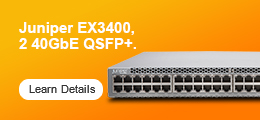Cisco offers a comprehensive portfolio of WDM transmission modules, including optical terminal filters, optical amplifiers, optical service channel, and others, to support the network applications of enterprise and service provider customers.
Models
Cisco ONS 15454 32-Channel 100GHz Optical Demultiplexer Card
Cisco ONS 15454 4-Band Optical Add/Drop Multiplexer Card
Cisco ONS 15454 4-Ch. 100GHz Optical Multiplexer/Demultiplexer Card
Cisco ONS 15454 4-Channel 100GHz Optical Add/Drop Multiplexer Card
Cisco ONS 15454 2-Channel 100GHz Optical Add/Drop Multiplexer Card
Cisco ONS 15454 1-Band Optical Add/Drop Multiplexer Card
Cisco ONS 15454 1-Channel 100GHz Optical Add/Drop Multiplexer Card
Cisco ONS 15454 Fiber Patch Panel Shelf
Cisco ONS 15454 Fiber Storage Shelf
CISCO ONS 15454 Optical Service Channel Card
Cisco ONS 15454 Splitter-Combiner Unit Optical Service Channel Card
Understanding WDM Technology and Which Option is Best for You
Users of today’s voice, video, and data networks are becoming more complex – requiring more bandwidth and faster data transmission rates over farther distances. To meet these demands, Many are turning to Wave Division Multiplexing (WDM) technologies in order to increase capacity on the fiber links that are already in place. WDM is a technology which multiplexes multiple optical signals on a single fiber by using different wavelengths, or colors, of laser light to carry the different signals. By utilizing bi-directional communications over a single fiber, network managers can realize a multiplication effect in their available fiber’s capacity.
A quick study of WDM yields three major options: Bidirectional Wave Division Multiplexing (BWDM), Coarse Wave Division Multiplexing (CWDM) and Dense Wave Division Multiplexing (DWDM). In order to provide consistent cost comparisons, only one manufacturer will be illustrated in the various examples. Due to their widespread market familiarity, we have chosen to use Cisco’s SFP, CWDM, and DWDM equipment in these comparisons.
- Bidirectional Wave Division Multiplexing (BWDM)
BWDM (also referred to as bi-di, simplex, and single strand) is the least expensive WDM solution, but also the most limiting as far as future proofing and anticipating tomorrow’s requirements of your network. When examining the pros and cons of BWDM you will find:
Benefits of BWDM: Inexpensive Requires little or no changes to the general construction of the current network Doubles the capacity of existing fiber routes.
Drawbacks of BWDM: Doubling the capacity may not be enough Requires having separate spares for each end of the link (up and downstream)
- Coarse Wave Division Multiplexing (CWDM)
CWDM increases fiber capacity in either 4, 8, or 16 channel increments. By increasing the channel spacing between wavelengths on the fiber, CWDM allows for a simple and affordable method of carrying up to 16 channels on a single fiber. Benefits and drawbacks of CWDM are:
Benefits of CWDM: Passive equipment that uses no electrical power Much lower cost per channel than DWDM Scalability to grow the fiber capacity as needed with little or no increased cost Protocol transparent Ease of use.
Drawbacks of CWDM: 16 channels may not be enough Passive equipment that has no management capabilities Costs significantly more per channel than BWDM
- Dense Wave Division Multiplexing (DWDM)
The last option available is a DWDM solution. DWDM comes in two different versions: an active solution and a passive solution. An active solution is going to require wavelength management and is a good fit for applications involving more than 32 links over the same fiber. In most cases, passive DWDM is looked at as a more realistic alternative to active DWDM. Here are the benefits and drawbacks of a DWDM solution:
Benefits of DWDM: Up to 32 channels can be done passively Up to 160 channels with an active solution Active solutions involve optical amplifiers to achieve longer distances
Drawbacks of DWDM: DWDM solutions are quite expensive Active solutions require a lot of set-up and maintenance expense Very little scalability for deployments under 32 channels



















































































































